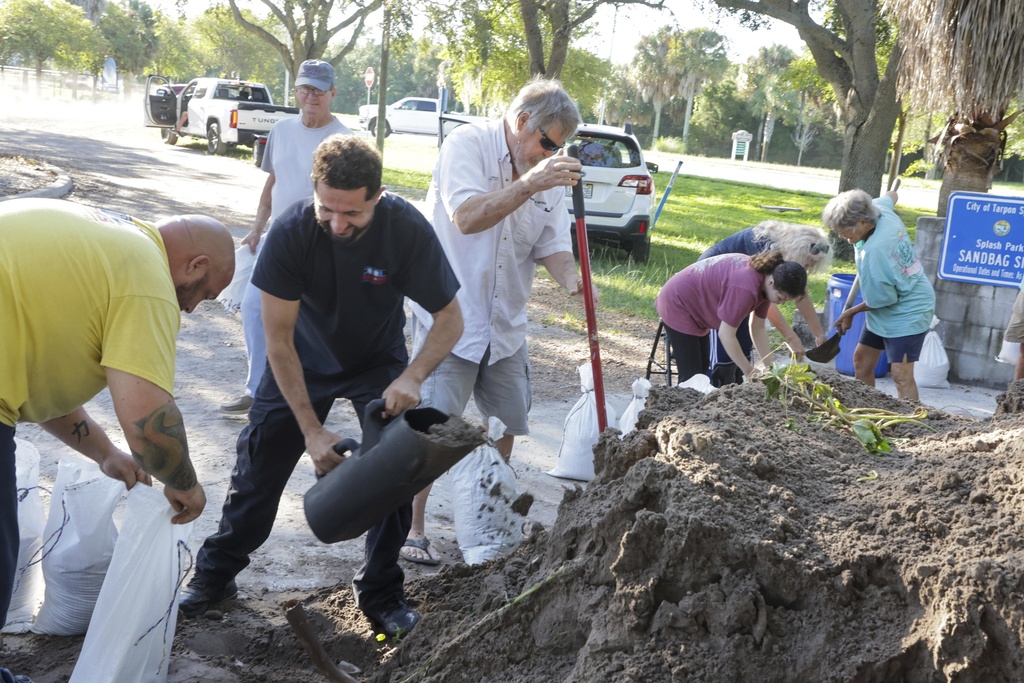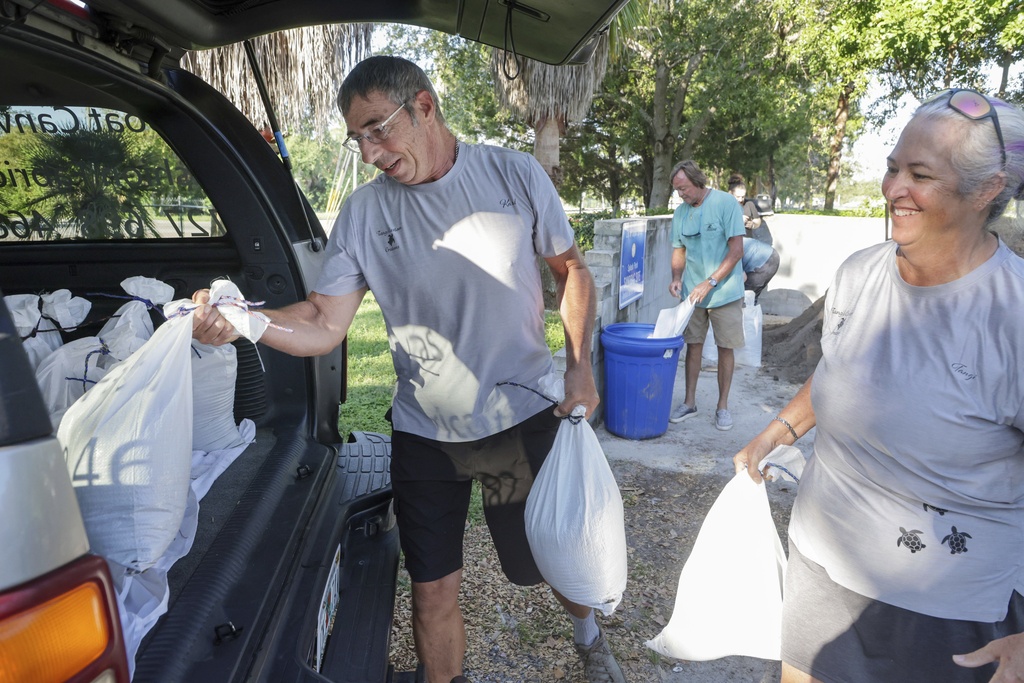Storm Helene Threatens Florida as It Strengthens Into Hurricane \ Newslooks \ Washington DC \ Mary Sidiqi \ Evening Edition \ Tropical Storm Helene formed in the Caribbean on Tuesday, bringing heavy rains and prompting evacuations across Florida and the Caribbean. Helene is expected to strengthen into a major hurricane as it approaches the U.S. Gulf Coast, with hurricane watches issued for parts of Cuba, Mexico, and Florida. The storm could bring flooding, high winds, and dangerous storm surges by Thursday.

Tropical Storm Helene Approaches: Quick Looks
- Formation and Path: Helene formed in the Caribbean and is moving toward the Gulf Coast, possibly becoming a major hurricane.
- Evacuations and Preparations: Residents in Florida are evacuating or filling sandbags, with hurricane warnings issued for Cuba and parts of Florida.
- Strengthening: Helene is expected to intensify into a hurricane by Wednesday and reach Category 3 strength by Thursday.
- Government Response: Florida has declared a state of emergency, while federal authorities are preparing resources for disaster relief.
- Storm Impacts: Heavy rainfall, strong winds, and storm surges are anticipated across Florida, Cuba, and the southeastern U.S.
Deep Look
Tropical Storm Helene took shape Tuesday in the Caribbean Sea, and forecasters are warning it could intensify into a major hurricane as it tracks north toward the U.S. Gulf Coast. The storm, already lashing the Cayman Islands with heavy rains and large waves, prompted evacuations in Florida, where residents filled sandbags in preparation for potential flooding.
As of Tuesday evening, Helene was located about 150 miles (240 kilometers) south of Cuba’s western tip, packing sustained winds of 50 mph (85 kph) and moving northwest at 12 mph (19 kph). The U.S. National Hurricane Center (NHC) expects Helene to become a hurricane by Wednesday as it crosses warm waters in the Gulf of Mexico, where conditions could fuel its transformation into a major hurricane by Thursday. Forecasters predict the storm could grow into a Category 3 hurricane, with winds exceeding 111 mph (178 kph), posing a significant threat to the northeastern Gulf Coast.
Hurricane Watches and Warnings Issued In anticipation of the storm’s strengthening, the NHC has issued hurricane watches for parts of Cuba, Mexico, and Florida, including Tampa Bay. A tropical storm warning is also in place for areas of the Florida Keys, where storm preparations are underway. Residents along Florida’s Gulf Coast are taking precautions, with some areas already ordering evacuations ahead of the storm’s expected landfall. Governor Ron DeSantis expanded the high-risk zone from 41 to 61 counties on Tuesday, urging residents to take the storm seriously and follow local directives.
As part of disaster readiness efforts, President Joe Biden declared a state of emergency in Florida, allowing federal authorities to position resources such as generators, food, and water ahead of the storm. Search-and-rescue teams and power restoration crews are also being mobilized in preparation for the damage that could ensue.
Evacuations and Storm Preparations The threat of Helene has already led to several disruptions in Florida. NASA and SpaceX postponed Thursday’s planned astronaut launch, moving the event to at least Saturday due to concerns over the storm’s impact. Additionally, Florida A&M University announced the postponement of its college football game against Alabama A&M, while many Florida counties urged or ordered evacuations.
Larry Kelly, a hurricane specialist at the NHC, warned that because Helene is expected to become a large storm, its effects could be felt across the entire state of Florida, not just in the immediate path of its center. “It’s important not to focus solely on the storm’s track,” Kelly cautioned, explaining that the storm’s far-reaching impacts could bring widespread wind, rain, and storm surge to multiple regions.
Memories of Past Hurricanes For some Floridians, the approach of Helene brings back traumatic memories of previous storms. Hal Summers, a restaurant worker from Mexico Beach, Florida, vividly recalled surviving Hurricane Michael in 2018, a Category 5 hurricane that took a deadly and destructive toll on the western Florida Panhandle. Summers, who lost his home in the storm, evacuated on Tuesday, saying, “That was such a traumatic experience that I knew staying wasn’t an option.”
Governor DeSantis has drawn comparisons between Helene and Hurricane Michael, both of which rapidly intensified, leaving residents with little time to prepare. State officials have urged Floridians to take the necessary precautions, warning that Helene could similarly intensify quickly as it nears land.
Economic and Environmental Impact While concerns over the storm’s potential destruction loom large, Florida’s Chief Financial Officer Jimmy Patronis remains cautiously optimistic that the state will recover quickly from Helene if it follows the paths of recent hurricanes like Idalia and Debby, which hit Florida in the past two years. Patronis noted that those storms had already cleared away many vulnerable structures and weakened trees, reducing the potential for severe debris in Helene’s wake.
However, forecasters warn that Helene is moving over very warm waters, a key ingredient in fueling rapid storm intensification. The NHC predicts that Helene could bring up to 8 inches (20 centimeters) of rain to western Cuba and the Cayman Islands, with isolated totals of up to 12 inches (30 centimeters) in some areas. The storm is expected to generate heavy rainfall across the southeastern U.S. starting Wednesday, potentially triggering flash flooding in Florida, Georgia, and neighboring states.
As the storm moves through the Gulf of Mexico, it will bring storm surges of up to 15 feet (5 meters) to parts of the Florida coast, particularly from the Ochlockonee River to Chassahowitzka, with additional surges of up to 10 feet (3 meters) possible in other areas. Residents have been urged to prepare for power outages and ensure they have enough food, water, and supplies to last at least three days.
Storm Surge and Flooding Risks In Florida, a storm surge watch has been issued for Tampa Bay, Charlotte Harbor, and areas from Indian Pass to Flamingo, while a tropical storm warning is in effect for the lower Florida Keys and parts of Mexico and Cuba. In the Cayman Islands, authorities closed schools, airports, and government offices as Helene swept through the region, causing power outages and flooding. Heavy rains and 10-foot (3-meter) waves flooded parts of Grand Cayman as the storm passed.
Many Cubans are also concerned about the storm’s approach, particularly as Helene threatens to impact the capital of Havana, which has been struggling with a severe shortage of water and ongoing power outages. Helene is expected to pass between Cuba and Mexico’s Yucatan Peninsula before heading northward toward the U.S. Gulf Coast by late Wednesday.
Ongoing Hurricane Season Helene is the eighth named storm of the 2024 Atlantic hurricane season, which runs from June 1 to November 30. The National Oceanic and Atmospheric Administration (NOAA) has predicted an above-average hurricane season, citing record-warm ocean temperatures that have contributed to more frequent and intense storms. NOAA has forecasted between 17 and 25 named storms this year, with up to seven major hurricanes of Category 3 strength or higher.
As the Atlantic season continues to intensify, Helene threatens to be a significant storm, with its impacts likely to be felt across multiple states, stretching as far inland as Tennessee, Kentucky, and Indiana.







